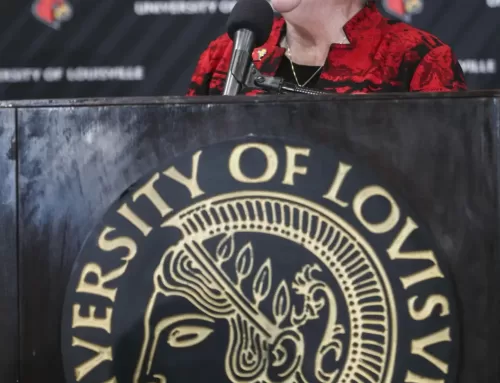By Simon Isham and Wes Kerrick–
The Grawemeyer Awards were named after H. Charles Grawemeyer, a Louisville native and Speed School graduate whose business savvy made him a respected investor and philanthropist throughout his life.
Grawemeyer created the awards in 1984, honoring the fields of education, music composition, psychology, improving world order and religion. The award in religion is presented by both the University of Louisville and the Louisville Presbyterian Theological Seminary.
The awards, given annually, include a monetary component of $100,000. Grawemeyer’s vision when he devised the awards was to create a prize to honor innovative ideas rather than personalities. To this end, he dictated that the official juries should consist of members who are laypeople, but who are nonetheless knowledgeable in their fields, such that academic reputation would not interfere in the selection process.
The four of the five 2013 Grawemeyer Award winners gave presentations to U of L students over the past week. The Grawemeyer award winner for music composition, Dutch composer Michel van der Aa, will give his presentation on April 23 at 3 p.m. in Bird Hall of the School of Music. His award was granted for a 30-minute multimedia cello concerto titled “Up-close.”
Of justice and psyche
Irving Gottesman, a schizophrenia researcher, won the 2013 Grawemeyer Award in psychology. He delivered his lecture, titled “Gaps in Our Understanding of the Causes of Mental Disorders: Endophenotypes to the Rescue!” in Comstock Hall at the School of Music on April 10.
Gottesman began his speech by promising the audience that by the end of it, they would not only understand what endophenotypes are, but would be readily employing the word in everyday conversation.
Endophenotypes are heritable genetic factors which indicate the presence of an illness of some kind. The term was coined in 1966 in a paper by two biologists working to explain the geographic distribution of grasshoppers in Australia, but was soon expanded to apply to both physical and mental ailments.
Gottesman documents the endophenotypes of schizophrenia, attempting to establish the bounds of the disorder in order to clarify the role that genetics and the environment play in its onset, particularly in patients who show no predisposition to schizophrenic behavior.
Gottesman and his late research partner, James Shields, performed twin studies at Bethlem Royal Hospital in London in the 1960’s. Through their research and Gottesman’s followup interviews in the 1990’s, they were able to project a comprehensive model of the likelihood that a person would develop schizophrenia at some time in his or her life, based on his or her relatedness to a person with the disorder.
The pair found that one percent of the general population developed the disorder, while six percent of people with a schizophrenic parent would ultimately inherit it. Identical twins, however, share more genetic material with one another than they do with one parent; Gottesman and Shields found that a staggering 48 percent of people whose twin was a schizophrenic would develop the disorder before their deaths.
In the late 1990’s, Gottesman’s research was called upon to serve a very practical application. He was asked to serve as an expert witness in the court case of three Hong Kong men who had developed schizophrenia and been fired. Gottesman described the men as having had “good jobs” and having had to carry sidearms as a result of these jobs.
“Is it fair,” he asked, “that these men were fired after developing schizophrenia?”
Gottesman said that Chinese officials were worried that schizophrenia was “contagious, like measles” and that their mental condition might provoke them to violence. Gottesman set the record straight by pointing out that his research indicated that while 13 percent of children with a schizophrenic parent are at a greater risk for developing schizophrenia than their peers are, 73 percent of children in this situation have a lower risk than their peers.
The judges were astonished, and granted the men one million Hong Kong dollars each. The men’s employers also offered them their jobs back, but all three of the claimants refused, fearing that they would not be treated well by their supervisors and coworkers upon returning to their jobs.
Gottesman pointed out that, because of the societal stigma against people who have been treated for mental disorders, some ex-patients experience discrimination in both the professional and social spheres of their lives.
Gottesman’s research is helping to facilitates a social change in perspective, however. As the person who nominated Gottesman for his Grawemeyer Award wrote, “(His) idea has transformed our assumptions about the origins of psychological disease and wellness and, in turn, has helped to shape our contemporary understanding of the complexities of human nature.”
Education reform from the outside in
The 2013 winner of the Grawemeyer Award in education spoke April 11 to about 90 people in the University Club ballroom. Beginning at 4:30 p.m., Finnish educator Pasi Sahlberg discussed the keys to Finland’s educational success. While the U.S. is working hard to improve education, it is doing so the wrong way, he said.
Educators worldwide flock to Finland to learn from its renowned educational system. “Our ministry of Education and Culture is considering changing its name to the Ministry of Education and Tourism,” Sahlberg joked.
The audience laughed.
Sahlberg credited his nation’s success, in part, to the fact that it does not approach education as a competition. “Nobody in Finland would like to claim that we have the best educational system in the world.” This attitude shows up in the educational system itself, in which schools seek to collaborate, not to compete with one another, he said.
Salhberg explained that educators in the U.S. and elsewhere have been striving to improve through implementing the Global Educational Reform Movement. The movement emphasizes competition among schools, standardized testing and the use of test scores for teacher accountability. All of these ideas, Sahlberg said, are misguided. He described the movement as an attempt at “doing a wrong thing righter.”
Mikkaka Hardaway, a literacy consultant with the Kentucky Department of Education, attended the lecture. “To hear it from someone outside, it was a little hard to swallow,” she said afterward. “There were a lot of aha moments.”
Sahlberg showed on a graph that worldwide, educational success seems to get worse as income inequality rises. Income inequality is much higher in the U.S. than it is in Finland, and Sahlberg said this is part of the reason American education is behind. He also cited studies showing that 89 percent of Finns rank the educational system as their most trusted public institution. By contrast, only 29 percent of U.S. Americans trust the educational system more than any other public institution.
In Finland, teachers are highly respected professionals, Sahlberg said. To become a primary school teacher, one must hold a master’s degree. And not just anyone is accepted into the program. He talked about a university that recently accepted only 120 of 2,000 applicants.
Also among the audience was U of L graduate John Kaelin, who is pursuing his master’s in secondary education at Bellarmine University and aspires to teach at a local high school. “A lot of schools are getting heat because their standardized tests aren’t up to snuff,” he said afterward. “Such a high level of competition, I think, is unhealthy.”
Education is just one of Finland’s successes. A 2009 Gallup poll ranked Finland’s people as second-happiest in the world. To this Sahlberg added that the Angry Birds game is a product of Finland. “So how many of you will go home here and say that Finland has angry birds and happy people?”
Attendees lingered for a reception afterward.
“It was amazing,” Hardaway said. “I felt like he had a lot of really great ideas.”
Into the minds beneath the veils
Leila Ahmed, the 2013 Grawemeyer Award winner in religion, explained to an audience at the Louisville Presbyterian Theological Seminary why she believes that Muslim women in the U.S. are increasingly donning the hijab, a veil covering the head.
Ahmed is a feminist and professor at Harvard University who was honored for her book, “A Quiet Revolution: The Veil’s Resurgence from the Middle East to America.” Over the past decade, Ahmed noticed a dramatic increase in the percentage of Muslim women who chose to observe hijab.
Growing up as an Egyptian woman in 1940’s Cairo, Ahmed was not raised in a generation with covered heads, as previous generations had done. When she saw that the trend was being revived in the West, she at first attributed this change to a dismissal of egalitarian ideals.
After her conversations with various Muslim women on this topic, however, her understanding of the practice’s modern iteration soon changed. Women from a range of backgrounds and ideological classifications wore veils as a symbol of their commitment to social change and equality.
Employing peace as a strategy
Erica Chenoweth of Denver, Colo. and U.S. State Department strategist Maria Stephan won a joint Grawemeyer award in improving world order for their work delving into the statistics and strategies of nonviolent conflict.
Chenoweth and Stephan used an open database to pull data for every civil war, globally, since the mid-1800s. They found that violent campaigns against a government are twice as likely to fail, whereas nonviolent campaigns are twice as likely to succeed in the present day. They have also projected that the rate of a nonviolent campaign’s success has increased over the past several years, as the percentage of success of nonviolent campaigns has decreased.
Why, they asked, is this trend so prevalent, “when all of our examples of literature point to the opposite?”The answer lies in a factor that the team call “the primacy of participation,” that is, that the quality and quantity of participation matters.
Whether violent or nonviolent, any campaign that is successfully able to persuade 12 percent of the total population to its cause will likely succeed, but as a general rule, nonviolent campaigns tend to attract more people and more types of people.
Violent campaigns usually require arming young, able-bodied individuals who may be required to possess certain skills, and who are more often than not males. Nonviolent campaigns, on the other hand, can be inclusive to people of all ages and skill levels. As Stephan put it, in a nonviolent campaign, “you can be a casual insurgent.”
Other statistics of particular interest that the team found were that violent insurgency tends to elicit more support from external forces than does nonviolent response, that the likelihood of a country achieving democracy with a nonviolent campaign is much higher within a five-year period than violent campaigns, and that nonviolent campaigns are 15 percent less likely to have a civil war resurgence within ten years after the end of the conflict.
[email protected]
Photos by Simon Isham/The Louisville Cardinal






